This is the complete guide to the 16 types of lawn mowers you can buy.
If you want to know which type of mower is best for your lawn, you’re in the right place.
Jump to a lawn mower type:
- Cutting Blade Types
- Walk Behind Mower Types
- Riding Mower Types
- Stand-on Mowers
- Tow-behind Types
- Automatic Mowers
Lawn Mower Cutting Blade Types
All lawn mowers come fitted with 1 of 2 types of cutting blade: rotary or cylinder.
See the differences:
1. Rotary Blade
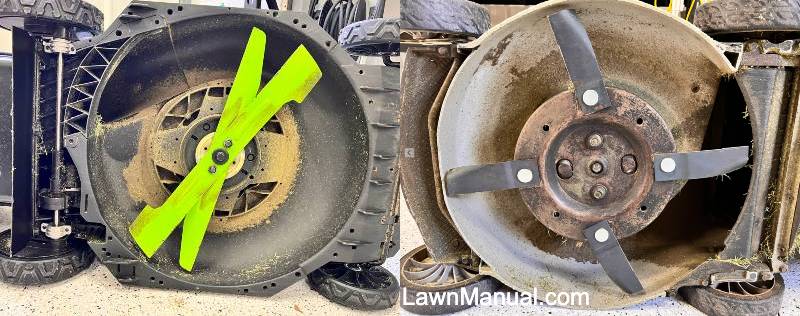
The most common lawn mower blade type is the rotary blade.
It rotates like a helicopter blade underneath a steel deck to chop the grass like a machete.
It is the most common because it is the least expensive with models on offer from lawn mower brands: Honda, Toro, DeWalt, Makita, Ryobi, Troy-Bilt, John Deere, Craftsman and more.
- Pros: 100s of mowers to choose from at all price ranges. Good enough cut quality for 99% of home owners. Deals with tough, thick, unkept grass with ease.
- Cons: Can’t cut the grass as low as cylinder blade (lower limit of 3/4″). Chops (instead of scissor cutting) grass leaving the turfgrass less healthy and more likely to suffer.
2. Cylinder/Reel/Drum Blade
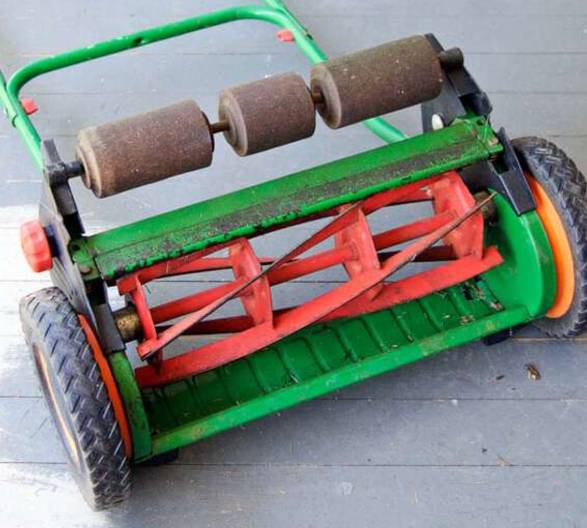
The most lawn obsessed homeowners and professional groundkeepers use cylinder mowers.
Some use manual-powered (human powered) reel mower styles but the pros use gas or battery powered versions.
Why?
Because cylinder blade mowers give the highest quality cut at the lowest possible height. This is perfect for golf green quality lawn.
You may be wondering if the drum style blade mower is the best why isn’t it more popular?
Let’s look at the pros and cons of the 2 different cylinder mower styles:
Human Powered
- Pros: Silent with no emissions. Safe because blades aren’t moving fast. High cut quality. Affordable machine with few moving parts. Low maintenance because no engine.
- Cons: Hard manual labor for mowing all but the smallest of lawns. Must keep blades razor sharp to work. Won’t get through high or tough grass.
Engine/Motor Powered
- Pros: Highest cut quality. Can cut turfgrass below 3/4″. Self propelled so you don’t have to push.
- Cons: Expensive. All the cons of having an engine: emissions, maintenance, loud. Cylinder blades rotating fast so keep your feet and hands clear.
Walk Behind Mower Types
The majority of homeowners own a walk behind lawn mower.
Do you?
Within the walk behind mower type, you have: gas powered, battery electric, corded electric, push, self propelled and hydrostatic.
See the differences:
3. Gas Powered
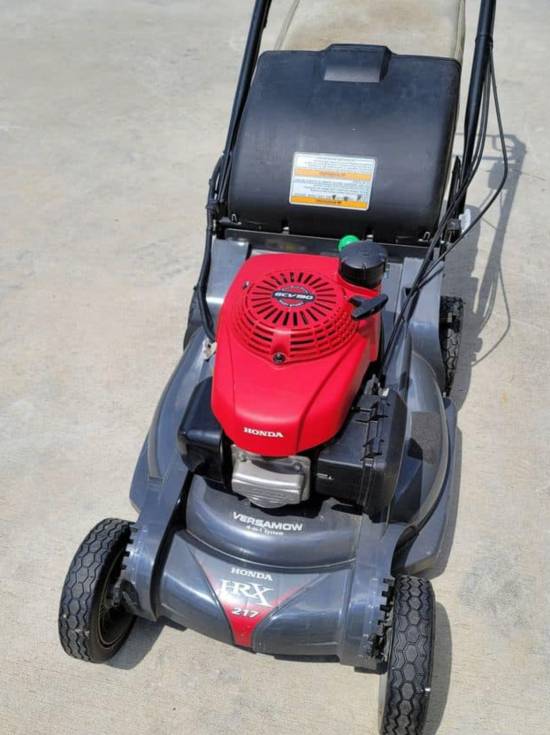
At present day gas powered lawn mowers account for 50% of walk behind mower sales. Electric mowers are fast taking over – especially battery powered cordless mowers. It is predicted by 2026 battery powered lawn mowers will be the bestselling lawnmower type.
Small gasoline engine powered lawn mowers have been around for over 100 years.
You have probably used several in your life.
They have a small gasoline engine mounted on a deck that moves around on 4 wheels and a handlebar you push and walk behind.
The most popular brands are Honda and Toro.
- Pros: Affordable. Many models to choose from. Offer good power to weight and size ratio. Service shops available in all towns (even small towns). Parts available. Handle tough grass with ease. Small and compact for easy storage. Easy to move around your lawn – even if you have hills and garden beds.
- Cons: Loud. Have emissions. Engine requires maintenance.
4. Battery Electric

Battery powered electric mowers were unheard of 20 years ago.
Now they are all you hear about.
With massive battery efficiency improvements and decrease in cost they are fast becoming the most requested lawn mower type at big box stores and online at Amazon and Home Depot.
Brands like EGO, Milwaukee, DeWalt, Ryobi, Greenworks, Makita and many others have cordless battery powered mowers on offer.
Having used all of these brands the two main problems with the battery electric type of mower are:
- High upfront cost of battery
- Mowing time on 1 charge is not great (20 – 45 mins depending on battery size used).
Still they have many upside over gas mowers and as we see the world seems to moving towards electric everything – cars, mowers, motorcycles, scooters etc.
Let’s look at the pros and cons:
- Pros: Cordless. Quiet. No fumes. No maintenance. Compact and easy to store upright in garage. Light.
- Cons: Mow time on 1 charge (depending on battery size) is 20 – 60 mins (ideal for small lawns of tennis court up to basketball court size, with well kept grass). High upfront cost even compared to premium model gas mowers. Lower power than gas (about 1/2 to 1/4 the horsepower) so it may stall in tall, wet, tough grass.
5. Corded Electric
Corded electric lawn mowers have long been the most popular option for people with small lawns close to their home. For example, inner city suburb homes with boxing ring size front and back lawns.
These days you can buy corded electric lawn mowers for $120 from brands like Ryobi, Greenworks, American Lawn Mower Company and Makita.
Their main annoyance is the cord getting in the way… But being connected to electricity means no running out of power when mowing the lawn.
If you have a small lawn and don’t care about the cord then this type of mower is for you.
- Pros: Affordable. Light. No fumes. No maintenance. Small and easy to store in closet or shed. Quiet.
- Cons: Cord is annoying. Less efficient brushed/universal motor compared to battery electric mower. Less power than gas mower. Low cost often means cheaper plastic components.
6. Push
The push type lawn mower refers to gas, electric or reel mowers you have to push with your own energy to move forward. They has no drive system to propel it forward for you.
We prefer self propelled mowers because they make mowing easier – even if you have a bad back or sore knee… But push mowers are less expensive and have less parts to maintain (no drive system).
All brands offer a push model and then offer self propel as an upgrade feature.
Here’s some pros and cons compared to self propelled mower types:
- Pros: More affordable. Less components needing maintenance.
- Cons: More effort to push forward.
7. Self Propelled
Self propelled lawn mower types (gas and electric) use a pulley, belt and gear drive system to turn the drive wheels on the mower and propel it forward.
The drive wheels can be the rear wheels, front wheels or all wheels.
Self propelled mowers can also be push mowers by not engaging the self propel feature. You have the choice. Some mower have the option to change the speed of the self propel feature so you can go from turtle speed to a fast walk behind the mower.
Self propelled mowers are recommended if you have a hilly lawn or nagging back/leg injuries. Self propel will make it easier for you to get out and enjoy mowing the lawn without exerting yourself.
- Pros: Makes mowing zero effort and more enjoyable – especially on hot, sunny days.
- Cons: Slightly more expensive than push mowers. Have to maintain the belt in the drive system.
8. Hydrostatic (Transmission)

All the most experienced lawn care pros use hydrostatic drive (pump + motor) mowers instead of a belt/pulley or gear drive systems like in the homeowner self propelled versions.
Why?
Because you get:
- Instant forward to reverse
- Infinite speed control (no gears to limit you)
- Easy steering
- Cruise control.
Mower types with hydrostatic transmissions have a hydraulic system (hydraulic motor + pump) which converts hydraulic fluid pressure and flow into torque for the lawn mower drive wheels to use for moving forward or reverse.
- Pros: Best-in-class control (response time, speed and sensitivity).
- Cons: Expensive. You have to maintain a hydraulic system.
Riding Mower Types
It is estimated 2.25 million riding mowers were sold in the U.S. last year.
1/4 of all mowers sold last year were riding mower types.
Riding mowers are the mower of choice for people mowing daily or mowing more than 1 acre a week.
How much lawn do you need to mow per week?
Do you have a 1 acre lawn (football field size)?
Here’s how long it takes to mow 1 acre with different lawn mower types:
- Push mower: 101 minutes
- Rear engine riding mower: 40 minutes
- Lawn tractor riding mower: 18 minutes
- Zero turn riding mower: 8.5 minutes
Let’s look at the difference between the different riding mower types: Rear engine, lawn tractor, garden tractor and zero turn.
See the differences:
9. Rear Engine
The most entry level and most affordable riding mower is the rear engine type.
These come with a small gas engine and cutting width of up to 40″.
The max speed of the top rear engine mower is 5 mp/h (8 km/h) to mow 1 acre in 40 minutes.
An advantage of these mowers is how versatile they are. You can get through fence gates meant for walking and mow your backyard just like a push mower. But they are also great for large 1-2 acre lawns that would take a push mower 4 hours.
- Pros: Entry level, most affordable riding mower. Much quicker than push mower. Zero effort as you are sitting down enjoying the mow.
- Cons: Not as quick or powerful as other riding mower types. Much more expensive than a walk behind mower type.
10. Lawn Tractor
Lawn tractors are the middle ground in riding mowers.
They are bigger and more powerful than rear engine riding mowers but smaller and less powerful compared to garden tractors.
Lawn tractors are tractors and can have attachments for grass bagging, trailer for hauling small loads and different spraying, de-thatching, and aerating attachments.
If you are a homeowner and want a riding mower this is probably your best option. If you own a farm or rural property then 1 of the below mower types may be better suited.
Lawn tractor pros and cons:
- Pros: Faster and wider cutting width than rear engine type. Can have attachments. More affordable than garden tractor type.
- Cons: Not great on hills compared to below types. Attachments are limited in size and function compared to garden tractors. Will usually come with inferior engine brand (i.e. not a Honda or Kawasaki but instead a Kohler or Briggs).
11. Garden Tractor
Garden tractors are your premium riding mower for landscape association professionals and farm & large rural property owners.
They are bigger, heavier, more powerful and better suited for long working days compared to lawn tractors.
Fitted with diff locks, 4WD a transaxle and a large engine garden tractors are great on hills and will not lose control on uneven or loose ground like mud or sand.
Being the most powerful and capable – of the tractor mowers – they also have the larger cutting width. John Deere make garden tractors with up to 60″ cutting width on their X700 series.
Of course all these advantages over the lawn tractor comes with a hefty price tag.
- Pros: Bigger grass cutting width. More power for hills and speed. More attachments available.
- Cons: More expensive. Bigger and harder to find place to store. Can’t get into tight spots.
12. Zero Turn
Zero turn mower types have the widest range from entry level to commercial duty.
You can get $3,500 zero turns and you can get $35,000 zero turns.
Zero turns have the largest cutting widths and are the fastest and most maneuverable of the riding mower types.
As the name suggests, zero turn mowers can turn on a dime.
Here’s how:
- Large rear wheels. Small front wheels. Zero turns are rear wheel drive so the drive axle needs bigger tires for grip and stability. The small front steering tires allows for 90-degree turning because the wheels aren’t hitting anything at full range.
- Lap bar steering instead of steering wheel. Because the front wheels need to quickly get to 90-degrees to turn on the dime a lap bar system is much more efficient than turning a steering wheel.
Zero turn mowers are great for speedy mowing around flowerbeds, trees and other landscape features.
- Pros: Fast for quick mowing. Highly maneuverable. Large cutting deck width.
- Cons: Generally not great on hills unless you buy a specific made-for-hills model. No attachments available like a tractor.
Stand-on Mower Types
Stand-on mowers are the lesser known mower type that offers many of the same advantages of a walk behind and zero turn mower.
Let’s take a look:
13. Zero Turn Stand-on
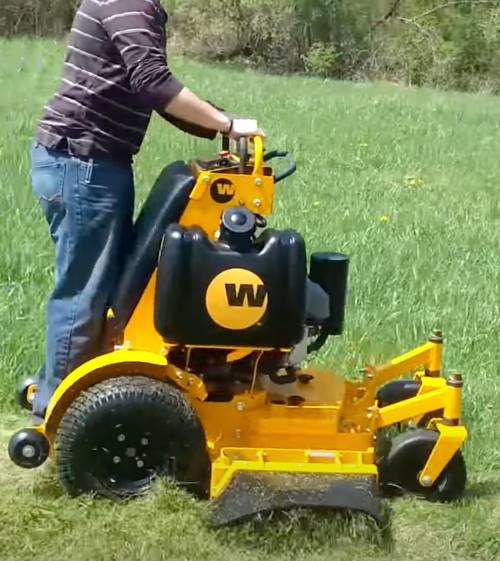
A stand-on mower is a versatile mower fitting between walk-behind and zero turn mowers in features and benefits.
All stand-on mowers are also zero turn mowers except you are standing at the back on a platform instead of sitting in the middle. It still has lap bar steering. It still has on-a-dime steering. It still has the option for a large cutting width.
Stand-on zero turns are more compact for storage and transporting on a trailer as the entire back end is cut off.
You can also use your body weight to lean into hills and tight bends – improving performance.
People love being able to quickly jump off the mower and move toys or rocks in the mowing path.
Another key aspect is you can use a standy mower as a walk-behind mower if need be.
- Pros: Higher view of mowing path. Versatile as you can stand or walk-behind. Still operates as a zero turn mower. Compact for storage and transport. Ability to lean bodyweight into hills and turns. More agile.
- Cons: Comparable cost to sit down zero turn mower. You have to stand up when mowing and ride quality is worse.
Tow-behind Mower Types
Tow-behind mowers are the ultimate time saver for mowing large plots of grass because you can mow 10 to 15-ft widths each pass.
Anything above 15 acres and you may want to check out the engine-powered tow-behind mowers.
The 2 types of tow-behinds are gang reel (manual or PTO powered reel/cylinder mowers in series) and engine or tractor-powered rotary mowers in series.
See the differences:
14. Gang Reel (Manual or Powered)
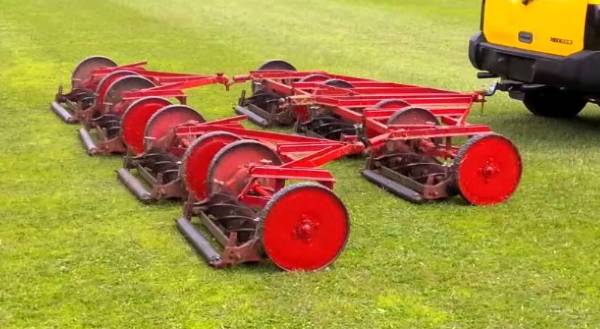
Tow behind gang reel mowers are reel mowers in series pulled on a trailer hitch.
The forward motion turns the cylinder blade guiding the grass to be cut by the bed knife at the base.
These tow-behind reel mowers (gang meaning multiple) can also be powered by an engine or PTO off a tractor.
Golf courses will use powered versions of these gang reel mowers for the rough and fairway.
- Pros: All the benefits of the cylinder reel mowing blade: lower cut height ability, higher cut quality.
- Cons: If not powered may struggle with thicker, longer grasses.
15. Rotary (Engine or Tractor-powered)
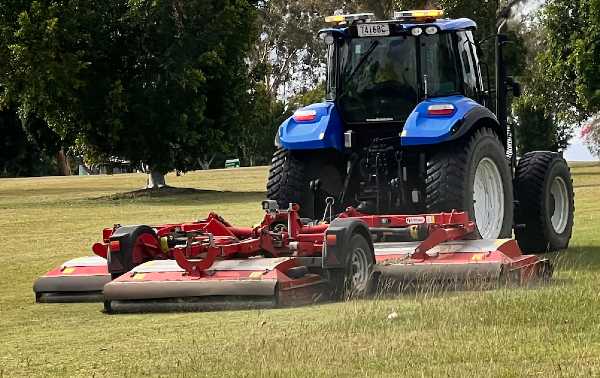
Engine-powered rotary blade tow behind mowers are used to mow large city parks and other 15+ acre grass areas with ease.
The tow-behind mower pictured above has 15-feet (4.6 m) of cutting width across 11 rotary blades and cuts our local 100 acre park in 6 – 7 hours (~15 acres/hour). It could cut it even faster if it was all level and there weren’t trees and walkways to avoid…
…But still it is 3x faster than the most hefty zero turns.
Workers usually attach via PTO to a tractor or you can get engine powered ones to tow behind your truck.
- Pros: Huge cutting width like having 11 people pushing 11 push mowers beside each other. Can tow behind a massive tractor so you never get stuck in the field – even if muddy. Can get PTO or engine powered types. Can detach from tractor and use on other size tractors. Folds side up for easier storage.
- Cons: Need a powerful tractor to tow and power. High upfront cost. Hard to maneuver around obstacles due to size.
Automatic Mower Types
Automatic robot mowers are battery powered rotary mowers that mow without your input.
They still cost more than a commercial-duty Honda mower so are yet to become popular.
How do they work?
Let’s see:
16. Robot Mower
Robot mowers use a combination of installed guide wires (that you place at barriers of your lawn – garden beds, obstacles etc.) and mapping software to learn your lawn over time.
They essentially go around your lawn until they hit a guide wire or other obstacle and then “remember” it in their software for next time.
- Pros: You don’t need to do anything except program how often it should mow and at what height. No maintenance.
- Cons: Expensive.
Other Grass Cutting Tools Not Considered Lawn Mowers
String Trimmer/Weed Wacker
A string trimmer uses nylon line or a blade (called brushcutter) spinning fast to trim grass down to your desired height.
String trimmers can definitely cut your lawn but it will take longer than a lawn mower and be less uniform in height.
Weed wackers are used to trim and edge grass in tight areas and angles close to concrete and other structures the lawn mower can’t reach.
Most lawn lovers own a lawn mower and a string trimmer.
- Pros: Easy to adjust grass cutting height. Get’s into tight areas and close to edges. Portable tool and easy to take with you anywhere.
- Cons: Will take longer to mow/cut a large area. Cutting height will be hard to keep the same over the surface area of a lawn.
Scythe
A scythe is manual tool used to cut grass in places people have no power but their own strength.
It is a sharp blade at the end of a pole that you swing side to side to cut the grass.
The blade needs to be very sharp and the rhythm takes practice.
But if you have the will and no other options it does the job of cutting down grass.
- Pros: Low upfront cost. No power required. No smoke or noise. No maintenance other than blade sharpening.
- Cons: High effort. Time consuming.
